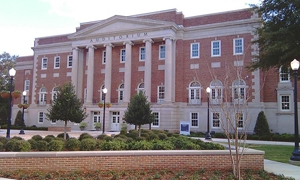“Stand In The Schoolhouse Door.” In 1963 Attorney General Nicholas Katzenbach,The Alabama National Guard and Federal marshals escorted Vivian Malone past Alabama governor George C. Wallace.This was a important event for desegregating the University of Alabama. Became a National Historic Landmark on April 5, 2005. built in 1939
capacity is 2,600 Seats, houses the women's volley balland basketball programs
Foster Auditorium is a historic building located on the campus of the University of Alabama in Tuscaloosa, Alabama. It was built in 1939 and was named in honor of former University of Alabama President George H. Denny. The auditorium served as the site of numerous university events, including sporting events and concerts, before gaining national attention for a much darker reason.
On June 11, 1963, Foster Auditorium became a focal point in the American Civil Rights Movement when Governor George Wallace attempted to block the enrollment of two African American students, Vivian Malone and James Hood, at the University of Alabama. Wallace stood in the doorway of the auditorium, declaring “segregation now, segregation tomorrow, segregation forever,” in a symbolic gesture of defiance against federal law mandating the integration of schools. This event is commonly known as the “Stand in the Schoolhouse Door.”
Today, Foster Auditorium is a National Historic Landmark and has been renovated to include the Autherine Lucy Clock Tower, named after the first African American student admitted to the University of Alabama. The building now houses the University’s Department of Theatre and Dance, as well as a museum that chronicles the events of the Civil Rights Movement and the integration of the University of Alabama.
The historic significance of Foster Auditorium cannot be overstated. It serves as a reminder of the bravery and determination of those who fought for civil rights in the United States, and the role that the University of Alabama played in this struggle. The building is a powerful symbol of both the progress that has been made and the work that still needs to be done in the ongoing fight for equality and justice.

